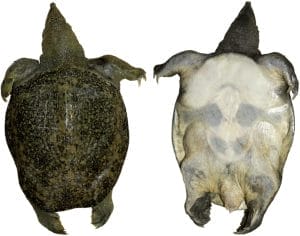Pelodiscus sinensis (Chinese Softshell Turtle)
Home > Turtle Database > Pelodiscus sinensis (Chinese Softshell Turtle)

The Pelodiscus sinensis, or Chinese softshell turtle, is known for its leathery shell and flexible body, quite different from the hard-shelled turtles we usually imagine. It’s a freshwater species widely farmed and found across Asia, valued for both culinary and cultural reasons.
Native To These Regions
Anhui (China), Fujian (China), Guangdong (China), Guangxi (China), Hainan (China), Hebei (China), Heilongjiang (China), Henan (China), Hubei (China), Hunan (China), Japan, Jiangsu (China), Jiangxi (China), Jilin (China), Korea, Liaoning (China), Shandong (China), Shanghai (China), Shanxi (China), Sichuan (China), Taiwan (China), Yunnan (China), Zhejiang (China)Native Turtle Species Map – Find Turtles by Region
Scientific Classification
- Kingdom: Animalia
- Phylum: Chordata
- Class: Reptilia
- Order: Testudines
- Family: Trionychidae
- Genus: Pelodiscus
- Species: Pelodiscus sinensis
Common Names
Chinese softshell turtle
Asiatic softshell turtle
This Hilarious Turtle Book Might Know Your Pet Better Than You Do
Let’s be real—most turtle care guides feel like reading a textbook written by a sleep-deprived zookeeper.
This one’s not that.
Told from the snarky point of view of a grumpy, judgmental turtle, 21 Turtle Truths You’ll Never Read in a Care Guide is packed with sarcasm, sass, and surprisingly useful insights.
And hey—you don’t have to commit to the whole thing just yet.
Grab 2 free truths from the ebook and get a taste of what your turtle really thinks about your setup, your food choices, and that weird plastic palm tree.
It’s funny, it’s honest, and if you’ve ever owned a turtle who glares at you like you’re the problem—you’ll feel seen.
Identification
Description
The Chinese softshell turtle has a flat, round, leathery shell without hard scutes. Its olive to dark green shell helps it blend into muddy waters. The turtle has a long neck and a snorkel-like nose, perfect for breathing while mostly submerged.
Sexual Dimorphism
Males tend to have longer tails and thinner bodies, while females are larger with shorter tails.
Check more turtles from the Pelodiscus genus
Native Origin and Distribution
Geographical Range
Native to China, Taiwan, Korea, Japan, and parts of Vietnam. It has also been introduced to areas like Hawaii and Thailand through farming and trade.
Preferred Habitat
This turtle prefers slow-moving rivers, ponds, marshes, and lakes with soft, muddy bottoms. It often buries itself in the mud, leaving just its head exposed for breathing.
Behavior
Feeding Habits
Pelodiscus sinensis is carnivorous, feeding on fish, insects, crustaceans, and mollusks. It hunts by ambush, lying in wait under the mud.
Predators
In the wild, they face threats from larger fish, birds, and mammals. Human activities like fishing and habitat destruction also pose risks.
Reproduction
Breeding Season
Breeding typically occurs in late spring to summer.
Reproductive Method
Females lay clutches of 8-30 eggs in sandy or muddy banks. The eggs incubate for about 60-80 days, depending on temperature.
Conservation
Extinction Status
Listed as Vulnerable by the IUCN.
Threats
Overharvesting for food markets, habitat loss, and pollution are the major threats.
Conservation Measures
Farming has reduced some pressure on wild populations, but regulations on wild capture and habitat protection are needed.
Economic Importance
The Chinese softshell turtle is highly valued in Asian cuisine and traditional medicine. It is widely farmed across China and Southeast Asia, contributing significantly to local economies.
Interesting Facts
Pelodiscus sinensis can breathe through its skin and pharynx while underwater, allowing it to stay submerged for long periods.
It is one of the most farmed turtle species in the world, with millions bred annually for consumption.

About Author
Muntaseer Rahman started keeping pet turtles back in 2013. He also owns the largest Turtle & Tortoise Facebook community in Bangladesh. These days he is mostly active on Facebook.













